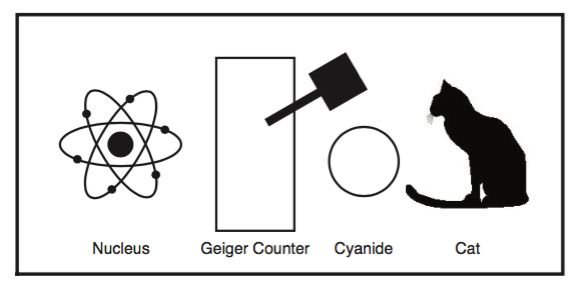Schrödinger Cat Paradox: Is Cat dead or alive?
Quantum mechanics is often challenging to understand if you are new to physics in college. In QM class, first thing you will hear is Schrödinger cat paradox -- is Schrödinger cat dead or alive? I understood most of the basic QM from the book called " Quantum Mechanics: A Paradigms Approach" by McIntyre et al. I encourage to use this book as a main reference to understand QM concept. You won't be disappointed. Here is the clear explanation of Schrödinger Cat Paradox from the book.
P.S: Do not expect to hear this kind of clear explanation from your physics professor in college.
The Schrodinger cat paradox is a gedanken experiment designed by Schrodinger to illustrate some of the problems of quantum measurement, particularly in the extension of quantum mechanics to classical systems. The apparatus of Schrodinger's gedanken experiment consists of a radioactive nucleus, a Geiger counter, a hammer, a bottle of cyanide gas, a cat, and a box, as shown in Fig. 1. The nucleus has a 50% probability of decaying in one hour. The components are assembled such that when the nucleus decays, it triggers the Geiger counter, which causes the hammer to break the bottle and release the poisonous gas, killing the cat. Thus, after one hour there is a 50% probability that the cat is dead.

Figure 1. Schrodinger cat gedanken experiment
After the one hour, the nucleus is in an equal superposition of undecayed and decayed states:

The apparatus is designed such that there is a one-to-one correspondence between the undecayed nuclear state and the live-cat state and a one-to-one correspondence between the decayed nuclear state and the dead-cat state. Though the cat is macroscopic, it is made up of microscopic particles and so should be describable by a quantum state, albeit a complicated one.
Thus we expect that the quantum state of the cat after one hour is

Both quantum calculations and classical reasoning would predict 50/50 probabilities of observing an alive or a dead cat when we open the box.
However, quantum mechanics would lead us to believe that the cat was neither dead nor alive before we opened the box, but rather was in a superposition of states and the quantum state collapses to the alive state or or dead state only when we open the box and make the measurement by observing the cat.
But our classical experiences clearly run counter to this. We would say that the cat really was dead or alive, we just did not know it yet.
The main issues raised by the Schrodinger cat gedanken experiment are (1) Can we describe macroscopic states quantum mechanically? and (2) What causes the collapse of the wave function?
Book: Quantum Mechanics: A Paradigms Approach by David McIntyre , Corinne A Manogue and Janet Tate.
Because the Observer is confused be sure the Universe is it NOT.
The Universe Reality don't care about the Confusion of the Observer, and more it does not care about the mathematical concepts of a confused Observer. The Universe don't calculates probabilities, it Knows the state of the cat. Only an Confused Observer needs a collapsing wave function to get a information what in essence existed prior.
Maybe just maybe it is easier to get over that confusion, instant to write math that try to prove the confusion is reality.
IT IS NOT, IT IS YOUR CONFUSION
The Pilgrims were the first to introduce cats to North America.